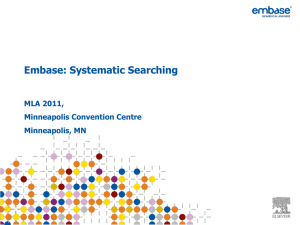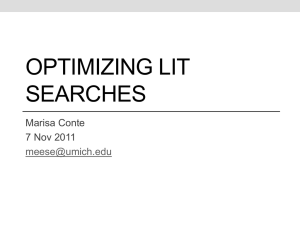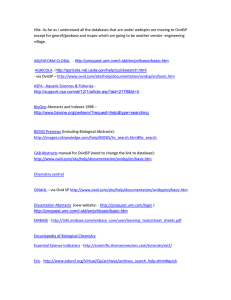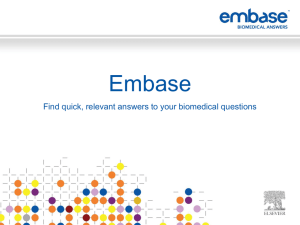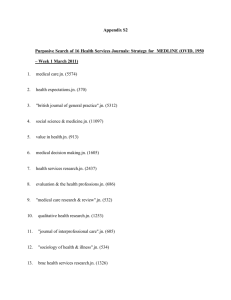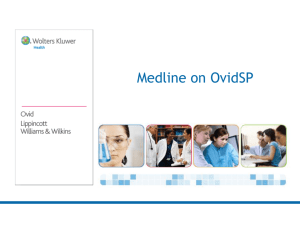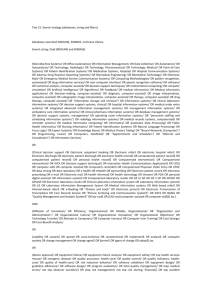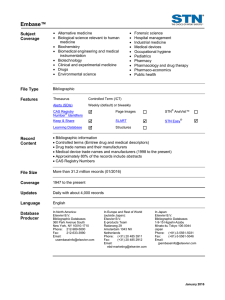Introduction to EMBASE on OvidSP Transforming Research into Results Yaqin.jiang@wolter skluwer.com
advertisement
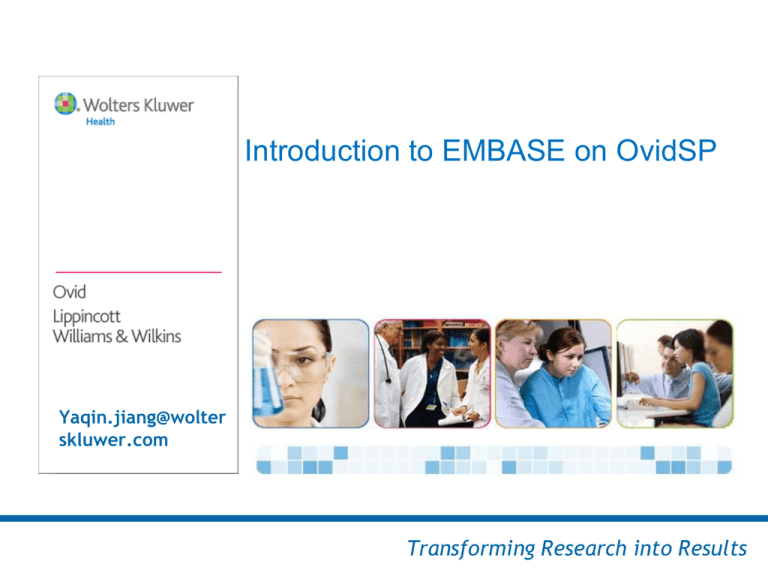
Introduction to EMBASE on OvidSP Yaqin.jiang@wolter skluwer.com Transforming Research into Results EMBASE Facts • Traditional EMBASE Subject Coverage: • Drug Research, Pharmacology, Pharmaceutics, Pharmacy, Side Effects and Interactions, Adverse Reactions and Toxicology • Human Medicine (Clinical and Experimental) • Biomedical Sciences • Biotechnology, Biomedical Engineering and Instrumentation • Health Policy and Management, Pharmacoeconomics • Public, Occupational and Environmental Health, Pollution • Substance Dependence and Abuse • Psychiatry • Forensic Science The focus of the database has expended due to the addition of Medline records 2 Embase Subject Coverage Scope: “Other” includes traditional MEDLINE topics such as dentistry, veterinary science, and nursing Embase now covers all Traditional EMBASE plus MEDLINE (just the core drug & clinical areas are highlighted here) 3 EMBASE Facts • Extensive Emtree thesaurus structure with many synonyms used in mapping and multidatabase searching with Medline • Thesaurus displays include numbers of records • Clearer thesaurus (plain English, not inverted) • Guided mapping and searching with easy access to all Emtree thesaurus displays, including drug and disease subheading roles • Comprehensive early coverage of pharmaceuticals during drug development stages • Early acquisition of drug names and synonyms or new subjects (as candidate terms) before reload • Better “Rest of the World” journal coverage 4 Introduction to Embase on OvidSP • Special fields for drug or medical device searching • Drug & Device trade name • Drug & Device manufacturer • CAS registry number • Important database specific limits – Clinical Trial limits to refine results to records on clinical trials or certain phase of drug development – Document types including conferences • Links to full text for subscribed or open access journals • Embase Natural language searching is available exclusively on Ovid Platform 5 Introduction to Embase on OvidSP • Database Coverage – Embase Alert – current eight weeks (~5 days after publication, with automated indexing) - Daily or Weekly updates Includes Articles in Press ahead of print. – Embase – 1988 to present, 1980 to present, (or 1974 to present*) (~approximately 10 days from publication) - Daily or Weekly updates – Embase Classic - 1947 to 1973* • Database subject subsets – EMBASE: Drugs & Pharmacology – EMBASE: Psychiatry *1974 to 1979 bridge segment is within the Embase Classic package 6 Introducing OvidSP Search Modes 7 Using Embase on OvidSP OvidSP offers a wide variety of search modes which will suit both an experienced researcher or a beginner • Search for whole topics or questions using Basic Search • Search for subjects interactively using Advanced Search • Search combinations of fields and subjects with MultiField Searching • Find or check references with Find Citation • Explore the subject structure ofthe APA Thesaurus with Search Tools • Browse or search one, more or all fields with Search Fields 8 Basic Search The purpose of Basic Search is to provide a useful number of highly relevant documents drawn from the most recent part of the database • Add related terms to include plurals and synonyms from the Ovid lexicon • Offers most relevant ranked results first (not most recent) • Can be limited (to Year or Full Text for example) Note: Use Sorting option or year limit to select recent publications 9 Basic Search 10 Basic Search 11 Advanced Search Advanced Search is an interactive research style search offering: • Mapping to subject headings (Emtree) • Keyword searching (.mp.) including title, abstract, subject headings & other subject fields • Author searching (interactive) • Title searching (words or phrases) • Journal searching (interactive) 12 Mapping 1. 2. 3. 4. Entering an exact match for an Emtree term in the controlled vocabulary; the term will appear and be selected, but other similar subjects will be listed (often a prompt to “explode”) Entering a synonym for a term, will direct you to the Emtree term (“explode” if a category or group of subjects) – Emtree to MeSH translation for example No match – Frequency based listing If term is neither a direct match nor listed as a "used for" term ("see” reference or synonym) then: – Ovid looks at citation where terms occurs in title or abstract or other fields… – Algorithm counts the occurrence of subject headings tied to those citations. – The most frequently occurring subject headings are presented to the user as choices. – In a frequency based list, one choice may be appropriate, or more than one or a combination of choices, or you may choose to “search as a keyword” “Cannot map term to a subject heading” – check spelling, or “search as a keyword” if very new or rare, this is an less usual response for a large database 13 Advanced Search 14 15 Advanced Search 16 Subheadings Disease Subheadings from 1988 (or later) eg complication, diagnosis, drug therapy, epidemiology, etiology, prevention, side effect, surgery, therapy etc Drug Subheadings from 1988 (or later) eg. Adverse drug reaction , Clinical trial, Drug administration, Drug combination, Drug comparison, Drug development, Drug dose, Drug interaction , Drug therapy , Drug toxicity, Endogenous compound, Pharmacoeconomics, Pharmacokinetics, Pharmacology etc Route of Drug Administration Subheadings from 2000 eg. Buccal drug administration, Epidural drug administration, Inhalational drug administration, Intraarterial drug administration, Intrabronchial drug administration, Intracardiac drug administration, Intracavernous drug administration, Intradermal drug administration, etc Often paired in practice – “adverse drug reaction” and “side effect” for example Note: by using subheadings you are also restricting your search to a range of years (see above), which is useful for current searches or alerts, but not for retrospective searches 17 Subheadings – Exceptions Disease Links –from 1988 except: – drug resistance – 1996 – disease management - 1997 Drug Links – from 1988 except: – Endogenous compound - 1991 – Pharmaceutics - 1991 – Pharmacoeconomics – 1997 18 Find Citation is a way of finding a small number of individual references by entering several variables as a single step • Enter combinations of author and title • Enter journal, volume, issue & page • Enter any other information – e.g. DOI or AN 19 Search Tools The Search Tools menu offers different ways of selecting subjects from the database subject structure • Mapping – suggesting subjects from the thesaurus • Tree – displaying the subject structure • Permuted Index – variations on a single word or theme • Subheadings – what subheadings are available • Explode – searches a subject and all of it’s parts or types 20 Search Fields Search Fields searching or browsing across one or more (or all) fields within a database • Display Indexes to select from a list of choices • Choose Search to search without browsing • Clear Selections to make different field choices 21 Fields of Note • CAS Registry Number – a number specific to individual chemical. Salts and variants may take a different number (includes a checksum) • Drug Trade Name – only used where that specific brand or dose form is important • Drug Manufacturer Name – for competitive information or disambiguation • Device Name – for medical devices • Device Manufacturer Name • Institution – academic institution or company name 22 Multi-field Searching Multi-Field Searching is a fast way of building searches within the fields of a database • Enter a subject (with truncation if necessary) • Choose a field to search • Select a combining operator – AND, OR or NOT • Add further subjects and selections… • Search 23 What other searching tools are available ? Combining • AND – both (or all) terms present • OR – either (or both) terms present • NOT – removes a term • ADJ# - ADJ6 within six words Truncation • * or $ - unlimited characters at the end of a word • *6 or $6 – six characters after a word • ? – one or zero characters at the end of or within a word • # - one variable character within a word 24 Basic Search 25 Advanced Search 26 Advanced Search 27 Limits • Two Types: • Commonly used limits – publication year, abstract, full text • Additional Limits – – – – – Broad subject areas – clinical queries Languages (most English language) Types of documents – review, book, conference paper Parts of the population – age groups, gender Special database subjects – experimental subjects, routes of drug administration 28 New Limits • Records From Medline or Embase: To distinguish records coming from Medline or native Embase records based on the Copyright field • Cochrane Library records (articles used in the production of CDSR) • Evidence-Based Medicine records (EBM) – you can choose to limit results set to EBM records or a subset of those such as Meta Analysis or Outcomes Research for example • Clinical Trials – allows limiting record set to clinical trial records or subsets of these. Phase 2 Clinical Trial records for example. 29 Output – Print/Email/Export 30 Links to Full-Text • Two Types: • Ovid Full Text – Journals@Ovid Subscriptions • Full Text – External full text both free or subscribed 31 Multi-File Searching – Embase and Medline together Two approaches: • For established subjects: For every MeSH term there is an equivalent Emtree term – so if you have done a successful Medline search, first try to re-execute in Embase & Medline together • For new subjects (especially for drug searches) a combination of Subject Headings and keywords may be necessary. Since all Medline records are now also in Embase, multifle searching may not be necessary for core Embase subjects. 32 Embase Database – now including new content EMBASE ~5,000 journals, approx. 2,000 unique – records indexed by Embase Approx. 3,000 overlapping journals – records indexed by Embase MEDLINE ~5,500 journals, approx 2,500 unique – records automatically reindexed from MeSH Original Embase Coverage Original Medline Coverage 33 Conference Abstracts • • • • Conference abstracts are available before the full proceedings get published (and many citations never get published at all). Using Conference Abstracts, your users can stay ahead of the most current research to track competitors, identify collaborators, and make sure they have access to the latest developments. Coverage begins in 2009, for over 250 conferences, with more than 60,000 conference abstracts added each year. Conferences published in more than 2800 key drug & clinical journals are included. Unique features: Every conference is summarized by a searchable review record All conference abstract records include searchable online abstracts All conference abstracts & reviews are indexed with Emtree terms Conference name, date and location are also searchable 34 Search & Limit to Conference Abstracts 35 Limit to Conference Abstracts 36 Conference Abstracts 37 Conference Abstracts 38 Conference Abstracts with Links 39 Conference Abstracts Alerts 40 Database Growth and Conferences in Embase Records (cumulative) Embase growth in 2010 700,000 180,000 Conference abstracts 600,000 (from 2009 + 2010) 500,000 168,000 400,000 300,000 Extra from MEDLINE 200,000 420,000 Traditional "EMBASE" 100,000 0 Jan Feb Mar Apr Month (2010) May Jun Jul in 2010 Embase has been growing faster than ever 41 More Information • http://www.info.embase.com/embase_suite/about/ • http://www.info.embase.com/embase_suite/user/in dexing_guide/embase_indexing_guide.pdf • http://www.info.embase.com/emtree/about/ • http://www.ovid.com – Training and Documentation, Training Resources, Learn More… – Tools Product Help, Ovid Platform 42 Search Examples • • • • • • • • Medical devices from Medtronic – competitive analysis Comprehensive search for IUD Managing high cholesterol in patients on Plavix Choice of anti-diabetics in obese children and adolescents Smoking and incidence of lung cancer Effects of exercise on White Blood Cells Quality Of Life after bladder surgery Special drug formulations 43 Combine subject heading with manufacturer to stay on top of your competitors Medtronic defibrillators – conference abstracts As Embase now includes conference abstracts you get most current information faster 44 Comprehensive search for medical device? Staying comprehensive with your medical device monitoring? You are if you are using Embase See all the terms used in an Embase search for intrauterine contraceptive device 45 Guidance on management of high cholesterol in patient on Clopidogrel (Plavix) • A Patient currently on Clopidogrel (Plavix) needs antihypercholesteremic medication because of high cholesterol • Search for Clopidogrel and select subheading Drug Interaction to check for potential drug interaction with this class of drugs or with any drugs within this class • Search for Statin – as it is a subject heading using mapping • Combine • 7 results help with guidance on the Statin to be chosen (or avoided) 46 Search strategy & results in this case 47 Reviewing current anti-diabetic drug therapies in obese children and adolescents • Search for anti-diabetic agent – map to subject heading and select Subheading - Drug Therapy • Use limits to narrow down search to human and children/adolescents:(human and (child <unspecified age> or preschool child <1 to 6 years> or school child <7 to 12 years> or adolescent <13 to 17 years>)) • Search for obesity and map this to the subject heading • Combine the two searches as illustrated on the next slide 48 Search strategy & results for this case 49 Smoking and Incidence of Lung Cancer • • • In advance search put in “smoking” and map to Emtree term Perform the same with lung cancer Same could be done with incidence but cancer incidence appears as part of the mapping display. So choosing that and combining the 3 searches… 50 Exercise effects on WBC count • • • • • In Advanced Search, input exercise and map to Emtree term Put in Advanced search WBC count and map to leukocyte count Combine the two searches Another approach is to use Basic Search and enter: “Exercise induced WBC elevation” Select 5 Star results to see the most relevant results 51 Bladder surgery effect on Quality of Life • “Quality of life” is an Emtree heading – offered if QOL is entered with mapping turned on • If you are not sure what type of surgery you would like to explore just type in surgery to see all the Emtree surgery terms – or use explode Combine the bladder surgery Emtree heading search with “Quality of Life” search using the AND operator to get targeted results 52 Drug Formulation • • • • Drug formulation is an Emtree term and if a special formulation of a drug is being investigated the search for Drug Formulation can be combined with the drug of interest Cardizem comes in both immediate and delayed release formulations. If the oral controlled release formulation is of interest, in Advanced search enter Cardizem, then focus by selecting the Subheading of Oral Administration Combine the above search with a Controlled release formulation search Note that if you put in delayed release, you are mapped to delayed release formulation and then by clicking on it and checking in Thesaurus view you can select Broader Term of Controlled release formulation 53 Questions? Thank You!
